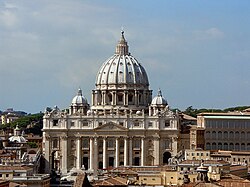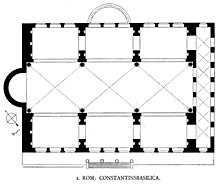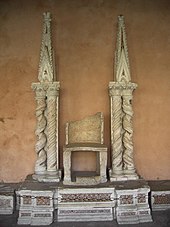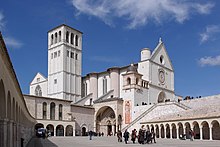Basilica: Difference between revisions
Pyrobob451 (talk | contribs) |
|||
| Line 68: | Line 68: | ||
The [[privilege]]s attached to the status of basilica, which is conferred by [[papal brief]], include a certain precedence before other churches, the right of the ''[[Umbraculum|conopaeum]]'' (a [[baldachin]] resembling an umbrella; also called ''umbraculum'', ''ombrellino'', ''papilio'', ''sinicchio'', etc.) and the bell (''[[tintinnabulum]]''), which are carried side by side in procession at the head of the clergy on state occasions, and the [[cappa magna]] which is worn by the [[Canon (priest)|canons]] or secular members of the [[collegiate chapter]] when assisting at the [[Liturgy of the Hours|Divine Office]].{{Citation needed|date=May 2009}} In the case of major basilicas these umbraculae are made of [[cloth of gold]] and red velvet, while those of minor basilicas are made of yellow and red silk—the colours traditionally associated with both the Papal See and the city of Rome. |
The [[privilege]]s attached to the status of basilica, which is conferred by [[papal brief]], include a certain precedence before other churches, the right of the ''[[Umbraculum|conopaeum]]'' (a [[baldachin]] resembling an umbrella; also called ''umbraculum'', ''ombrellino'', ''papilio'', ''sinicchio'', etc.) and the bell (''[[tintinnabulum]]''), which are carried side by side in procession at the head of the clergy on state occasions, and the [[cappa magna]] which is worn by the [[Canon (priest)|canons]] or secular members of the [[collegiate chapter]] when assisting at the [[Liturgy of the Hours|Divine Office]].{{Citation needed|date=May 2009}} In the case of major basilicas these umbraculae are made of [[cloth of gold]] and red velvet, while those of minor basilicas are made of yellow and red silk—the colours traditionally associated with both the Papal See and the city of Rome. |
||
Churches designated as papal basilicas, in particular, possess a papal [[throne]] and a papal [[high altar]], at which no one may celebrate Mass without the pope's permission. |
Churches designated as papal basilicas, in particular, possess a papal [[throne]] and a papal [[high altar]], at which no one may celebrate Mass without the pope's permission. {{Citation needed|date=November 2010}} |
||
Numerous basilicas are notable [[shrine]]s, often even receiving significant [[pilgrimage]]s, especially among the many that were built above a ''confessio'' or the burial place of a martyr – although this term now usually designates a space before the high altar that is sunk lower than the main floor level (as in the case in St Peter's and St John Lateran in Rome) and that offer more immediate access to the burial places below. |
Numerous basilicas are notable [[shrine]]s, often even receiving significant [[pilgrimage]]s, especially among the many that were built above a ''confessio'' or the burial place of a martyr – although this term now usually designates a space before the high altar that is sunk lower than the main floor level (as in the case in St Peter's and St John Lateran in Rome) and that offer more immediate access to the burial places below. |
||
Revision as of 03:20, 11 November 2010
This article may require copy editing for grammar, style, cohesion, tone, or spelling. (August 2009) |

The Latin word basilica (derived from Greek, Basilikè Stoá, Royal Stoa, the tribunal chamber of a king), was originally used to describe a Roman public building, usually located in the forum of a Roman town. Public basilicas begin to appear in Hellenistic cities in the 2nd century BC.
The term was also applied to buildings used for religious purposes. The remains of a large subterranean Neopythagorean basilica dating from the 1st century AD were found near the Porta Maggiore in Rome in 1915. The stuccoes on the interior vaulting have survived, though their exact interpretation remains a matter for debate. The ground-plan of Christian basilicas in the 4th century was similar to that of this Neopythagorean basilica, which had three naves, and an apse.
After the Roman Empire became officially Christian, the term came, by extension, to refer specifically to a large and important church that has been given special ceremonial rites by the Pope. Thus the word retains two senses today, one architectural and the other ecclesiastical.
Architecture


In architecture, the Roman basilica was a large roofed hall erected for transacting business and disposing of legal matters. As early as the time of Augustus, a public basilica for transacting business had been part of any settlement that considered itself a city, used in the same way as the late mediaeval covered market houses of northern Europe, where the meeting room, for lack of urban space, was set above the arcades, however. Such buildings usually contained interior colonnades that divided the space, giving aisles or arcaded spaces on one or both sides, with an apse at one end (or less often at each end), where the magistrates sat, often on a slightly raised dais. The central aisle tended to be wide and was higher than the flanking aisles, so that light could penetrate through the clerestory windows.
The oldest known basilica, the Basilica Porcia, was built in Rome in 184 BC by Cato the Elder during the time he was Censor. Other early examples include the basilica at Pompeii (late 2nd century BC).
Probably the most splendid Roman basilica (see below) is the one constructed for traditional purposes during the reign of the pagan emperor Maxentius and finished by Constantine I after 313 AD.
Basilicas in the Roman Forum
- Basilica Porcia: first basilica built in Rome (184 BC), erected on the personal initiative and financing of the censor Marcus Porcius Cato (Cato the Elder) as an official building for the tribunes of the plebs
- Aemilian Basilica, built by the censor Aemilius Lepidus in 179 BC
- Julian Basilica, completed by Augustus
- Basilica Opimia, erected probably by the consul Lucius Opimius in 121 BC, at the same time that he restored the temple of Concord (Platner, Ashby 1929)
- Basilica Sempronia, built by the censor Tiberius Sempronius Gracchus in 169 BC
- Basilica of Maxentius and Constantine (built between 308 and 312 AD)
Palace basilicas
In the Imperial period, a basilica for large audiences also became a feature in the palaces. In the 3rd century AD, the governing elite appeared less easily in the forums. "They now tended to dominate their cities from opulent palaces and country villas, set a little apart from traditional centers of public life. Rather than retreats from public life, however, these residences were the forum made private." (Peter Brown, in Paul Veyne, 1987). Seated in the tribune of his basilica the great man would meet his dependent clientes early every morning.
A private basilica excavated at Bulla Regia (Tunisia), in the "House of the Hunt", dates from the first half of the 4th century. Its reception or audience hall is a long rectangular nave-like space, flanked by dependent rooms that mostly also open into one another, ending in a semi-circular apse, with matching transept spaces. The "crossing" of the two axes was emphasized with clustered columns.
Christianization of the Roman basilica

In the 4th century, once Christianity had been decriminalized, Christians were prepared to build larger and more handsome edifices for worship than the furtive meeting places they had been using. Architectural formulas for temples were unsuitable, not simply for their pagan associations, but because pagan cult and sacrifices occurred outdoors under the open sky in the sight of the gods, with the temple, housing the cult figures and the treasury, as a backdrop. The usable model at hand, when Constantine wanted to memorialize his imperial piety, was the familiar conventional architecture of the basilicas.[1] These had a centre nave with one aisle at each side and an apse at one end: on this raised platform sat the bishop and priests. Constantine built a basilica of this type in his palace complex at Trier, later very easily adopted for use as a church. It is a long rectangle two storeys high, with ranks of arch-headed windows one above the other, without aisles (there was no mercantile exchange in this imperial basilica) and, at the far end beyond a huge arch, the apse in which Constantine held state. Exchange the throne for an altar, as was done at Trier, and you had a church. Basilicas of this type were built not only in western Europe but also in Greece, Syria, Egypt, and Palestine. Good early examples of the architectural basilica are the Church of the Nativity at Bethlehem (6th century AD), the church of St Elias at Thessalonica (5th century AD), and the two great basilicas at Ravenna.

The first basilicas with transepts were built under the orders of Emperor Constantine, both in Rome and his "New Rome," Constantinople:
- "Around 380, Gregory Nazianzen, describing the Constantinian Church of the Holy Apostles at Constantinople, was the first to point out its resemblance to a cross. Because the cult of the cross was spreading at about the same time, this comparison met with stunning success." (Yvon Thébert, in Veyne, 1987)
Thus a Christian symbolic theme was applied quite naturally to a form borrowed from civil semi-public precedents. In the later 4th century other Christian basilicas were built in Rome: Santa Sabina, St John Lateran, and St Paul's Outside the Walls (4th century), and later San Clemente (6th century).

A Christian basilica of the 4th or 5th century stood behind its entirely enclosed forecourt ringed with a colonnade or arcade, like the stoa or peristyle that was its ancestor or like the cloister that was its descendant. This forecourt was entered from outside through a range of buildings along the public street. This was the architectural ground-plan of St Peter's Basilica in Rome, until in the 15th century it was demolished to make way for a modern church built to a new plan.
In most basilicas the central nave is taller than the aisles, forming a row of windows called a clerestory. Some basilicas in the Caucasus, particularly those of Georgia and Armenia, have a central nave only slightly higher than the two aisles and a single pitched roof covering all three. The result is a much darker interior. This plan is known as the "oriental basilica."
Famous existing examples of churches constructed in the ancient basilica style include the church at Saint Catherine's Monastery, Mount Sinai and the Basilica of San Vitale in Ravenna.
Gradually, in the early Middle Ages there emerged the massive Romanesque churches, which still retained the fundamental plan of the basilica.
Basilicas in Eastern Orthodoxy
In the Eastern Orthodox Church, the basilica is a mere architectural description of churches built in the ancient style. It bears no significance with regard to precedence or importance of the particular building or clerics associated with it. Eastern basilicas may be single-naved, or have the nave flanked by one or two pairs of lower aisles; it may have a dome in the middle: in this case it is called a "domed basilica".
Roman Catholic churches designated as basilicas


The Early Christian purpose-built basilica was the cathedral basilica of the bishop, on the model of the semi-public secular basilicas, and its growth in size and importance signalled the gradual transfer of civic power into episcopal hands, which was under way in the 5th century. Basilicas in this sense are divided into classes, the major ("greater") basilicas and the minor basilicas; there are three other papal and several pontifical minor basilicas in Italy, and over 1,400 lesser basilicas around the world.
As of 31 December 2007, there were 1,524 basilicas (an increase from 1,476 on 26 March 2006), of which the majority are in Europe (532 in Italy alone, including all those of elevated status; 167 in France; 105 in Poland; 101 in Spain; 69 in Germany; 29 in Austria; 26 in Belgium; 15 in the Czech Republic; 13 in Hungary; 12 in Switzerland; 20 in the Netherlands; 10 in Slovakia; 8 on Malta; 7 each in Croatia and Slovenia,[2] 6 in Portugal; 5 in Lithuania; and fewer in many other countries), many in the Americas (62 in the United States, 50 in Brazil, 43 in Argentina, 27 in Mexico, 25 in Colombia, 21 in Canada, 14 in Venezuela, 12 in Peru, 9 in Chile, 8 in Bolivia, 5 in Uruguay, 4 in El Salvador, and smaller numbers elsewhere), and fewer in Asia (15 in India, 12 in the Philippines, 9 in the Holy Land (Israel/Palestine), with smaller numbers elsewhere), 16 in Africa (several countries have one or two) and Australasia (5 in Australia and 1 in Guam) and 5 (or 6, depending on definition) in New Zealand.
The privileges attached to the status of basilica, which is conferred by papal brief, include a certain precedence before other churches, the right of the conopaeum (a baldachin resembling an umbrella; also called umbraculum, ombrellino, papilio, sinicchio, etc.) and the bell (tintinnabulum), which are carried side by side in procession at the head of the clergy on state occasions, and the cappa magna which is worn by the canons or secular members of the collegiate chapter when assisting at the Divine Office.[citation needed] In the case of major basilicas these umbraculae are made of cloth of gold and red velvet, while those of minor basilicas are made of yellow and red silk—the colours traditionally associated with both the Papal See and the city of Rome.
Churches designated as papal basilicas, in particular, possess a papal throne and a papal high altar, at which no one may celebrate Mass without the pope's permission. [citation needed]
Numerous basilicas are notable shrines, often even receiving significant pilgrimages, especially among the many that were built above a confessio or the burial place of a martyr – although this term now usually designates a space before the high altar that is sunk lower than the main floor level (as in the case in St Peter's and St John Lateran in Rome) and that offer more immediate access to the burial places below.
Ranking of churches
The papal or major basilicas outrank in precedence all other churches. Other rankings put the cathedral (or co-cathedral) of a bishop ahead of all other churches in the same diocese, even if they have the title of basilica. If the cathedral is that of a suffragan diocese, it yields precedence to the cathedral of the metropolitan see. The cathedral of a primate is considered to rank higher than that of other metropolitan(s) in his circonscription (usually a present or historical state). Other classifications of churches include collegiate churches, which may or may not also be minor basilicas.

Major or papal basilicas
To this class belong only the four great papal churches of Rome, which among other distinctions have a special "holy door" and to which a visit is always prescribed as one of the conditions for gaining the Roman Jubilee. Upon relinquishing in 2006 the title of Patriarch of the West, Pope Benedict XVI renamed these basilicas from "Patriarchal Basilicas" to "Papal Basilicas".
- St John Lateran, also called the Lateran Basilica, is the cathedral of the Bishop of Rome, the Pope. It is the only one called an "archbasilica". Its full official name is "Papal Basilica of Saint John Lateran, Archbasilica of the Most Holy Saviour and of Saints John the Baptist and the Evangelist at the Lateran, Cathedral of Rome".[3]
- St Peter's Basilica, also called the Vatican Basilica, is a major pilgrimage site, built over the burial place of Saint Peter. Perhaps the largest church in the world, it is used for most of the chief religious ceremonies in which the Pope participates. Its official name is the "Papal Basilica of Saint Peter in the Vatican".[4]
- St Paul Outside the Walls, also known as the Ostian Basilica because it is situated on the road that led to Ostia, is built over the burial place of Paul the Apostle. Its official name is the "Papal Basilica of Saint Paul Outside the Walls".[5]
- St Mary Major, also called the Liberian Basilica because the original building (not the present one) was attributed to Pope Liberius, is the largest church in Rome dedicated to the Blessed Virgin Mary , whence its name of Saint Mary Major, i.e. the Greater. Its official name is the "Papal Basilica of Saint Mary Major".[6]
These four papal[7] or major basilicas were formerly known as "patriarchal basilicas". Together with the minor basilica of St Lawrence outside the Walls, they were associated with the five ancient patriarchal sees of Christendom (see Pentarchy)[8]: St John Lateran was associated with Rome, St Peter's with Constantinople (present-day Istanbul), St Paul's with Alexandria (in Egypt), St Mary Major with Antioch (the Levant) and St Lawrence with Jerusalem.
These four major basilicas are also distinguished by their having a holy door, opened only in a jubilee year. Furthermore, no one may celebrate mass at the high altar except the Pope and those specially delegated by the Pope to act in his stead. At least until recently, these churches were also open twenty-four hours a day and their staff included a college of priests whose sole function was to be continually available to hear confessions.
Pontifical and patriarchal minor basilicas in the rest of Italy

There are four other "pontifical" basilicas in Italy (the word "pontifical" meaning "papal", referring to the title pontifex maximus):
- the Pontifical Basilica of Our Lady of the Rosary of Pompeii
- the Pontifical Basilica of Saint Nicholas in Bari
- the Pontifical Basilica of Saint Anthony in Padua
- the Pontifical Basilica of the Holy House at Loreto
Until Pope Benedict XVI, the title "patriarchal" (now "papal") was officially given to two churches associated with Saint Francis of Assisi situated in or near his home town:
The description "patriarchal" still applies to the next class of basilicas, associated with archbishops who have the title of patriarch, notably
- the Patriarchal Cathedral Basilica of St Mark in Venice
- the Patriarchal Basilica of Aquileia, which with its archaeological area is a UNESCO World Heritage Site.

Other minor basilicas
The minor basilicas form the vast majority, including some cathedrals, many technically parish churches, some shrines, and some abbey or convent churches. Some oratories and semi-private places of worship, have been raised to the status of a minor basilica, such as Saint Joseph's Oratory in Montreal.
Notre-Dame de Québec Cathedral in Quebec City was the first basilica in North America, so designated by Pope Pius IX in 1874. The Basilica of Saint Mary in Minneapolis became the first Basilica in the United States, designated in 1926, by Pope Pius XI. In Colombia, the Las Lajas Cathedral has been a minor basilica since 1954. In Africa, the Basilica of Our Lady of Peace of Yamoussoukro, in Cote d'Ivoire is reported to be slightly larger than St Peter's Basilica.
The Basilica of Our Lady of Guadalupe, in Mexico City, is considered the second most important sanctuary of Roman Catholicism, second to the Vatican City on the basis of the number of pilgrims it hosts each year (between 12 and 20 million).[9] The Sanctuary of Lourdes in France, with several basilicas, receives between 5 and 6 million pilgrims each year.
There was a pronounced tendency in the 20th century to increase the number of churches that were granted the title of minor basilica. Examples among the many are the church containing Francisco Franco's tomb and those of many others in the monumental Valley of the Fallen near Madrid, the Mission San Carlos Borromeo de Carmelo, in Carmel, California, Manila Cathedral (also known as the Minor Basilica of the Immaculate Conception in Intramuros or the original Spanish settlement of Manila), and the Mission Basilica San Juan Capistrano. Towards the end of the century, stricter rules were applied and it was decided, for instance, that since cathedrals outrank basilicas in any case, the title of minor basilica would no longer be granted to them.
Gallery
While the great majority of ecclesiastical basilicas are found in Western Europe, there are basilicas in Eastern Europe, the Middle East, Africa, Asia, Australasia and the Americas.
Europe
Africa and the Middle East
-
Middle East: Basilica of St. Paul, Harissa, Lebanon
Asia and Oceania
The Americas
See also
Sources and references
Architecture
- Architecture of the basilica, well illustrated.
- Basilica Porcia
- W. Thayer, "Basilicas of Ancient Rome": from Samuel Ball Platner (as completed and revised by Thomas Ashby), 1929. A Topographical Dictionary of Ancient Rome (London: Oxford University Press)
- Paul Veyne, ed. A History of Private Life I: From Pagan Rome to Byzantium, 1987
- Heritage Foundation of Newfoundland and Labrador
Ecclesiastical basilicas
- List of All Major, Patriarchal and Minor Basilicas & statistics by Giga-Catholic Information
- Catholic Encyclopedia: Basilica & minor parts in other articles
- Richard Krautheimer, Early Christian and Byzantine Architecture
- Domus ecclesiae: Privileges and obligations pertaining to minor basilicas
References
- ^ Basilica Plan Churches
- ^ http://www.rtvslo.si/slovenija/cerkev-na-ptujski-gori-postala-bazilika/230283
- ^ Basilica Papale di San Giovanni in Laterano - Arcibasilica del SS.mo Salvatore e dei Santi Giovanni Battista ed Evangelista al Laterano - Cattedrale di Roma (Annuario Pontificio 2007, ISBN 98-88-209-7908-9, p. 1332
- ^ Basilica Papale di San Pietro in Vaticano (Annuario Pontificio 2007, ISBN 98-88-209-7908-9, p. 1330)
- ^ Basilica Papale di San Paolo fuori le mura (Annuario Pontificio 2007, ISBN 98-88-209-7908-9, p. 1333)
- ^ Basilica Papale di Santa Maria Maggiore (Annuario Pontificio 2007, ISBN 98-88-209-7908-9, p. 1334)
- ^ Basilicas
- ^ Adrian Fortescue (1913). . In Herbermann, Charles (ed.). Catholic Encyclopedia. New York: Robert Appleton Company.
- ^ Septién, Jaime (11 December 2007). "Our Lady of Guadalupe Attracting Record Numbers". Zenit. Retrieved 2009-12-12.
External links
- Procession with the conopaeum and tintinnabulum by the collegiate chapter of the Basilica of Sts Peter and Paul in Gozo, Malta
- First Basilica in the United States
- List of Basilicas



























